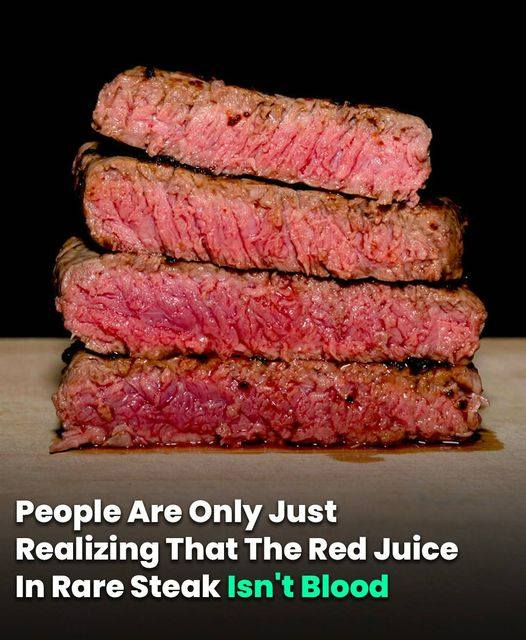When it comes to steak, everyone has their preference: rare, medium, or well done. However, before a perfectly cooked steak reaches the dinner table, it might not look all that appetizing sitting on the butcher’s shelf or in a grocery store. If you’ve ever noticed a red liquid seeping from the steak and assumed it was blood, you’re not alone—but that assumption is incorrect.

Social Media Reactions: A Surprising Revelation
Recently, social media has been buzzing with people discovering that the red liquid in rare steak is not actually blood. One user on X (formerly Twitter) exclaimed, “I was today years old when I learned that the red liquid in rare steak isn’t blood.” Another user responded, “I did not know that!” While some found the information surprising, others were a bit grossed out, with one person saying, “That’s worse, I don’t even know what that is.” Clearly, this revelation has sparked confusion and curiosity online.
But what exactly is this mysterious pinkish-red liquid? Let’s break it down.
The Real Source of the “Red Juice”
During the slaughtering process, almost all the blood is drained from the animal, leaving only trace amounts in even the freshest cuts of steak. What people often mistake for blood is actually a combination of water and a protein called myoglobin. This liquid, known in the meat industry as “purge,” is what gives the steak its juicy, reddish appearance.
Bearded Butchers explains that “all meat is around 75% water, which is contained within the muscle cells.” When meat is frozen and then thawed, ice crystals form, which can damage muscle cells. As the meat defrosts, water and myoglobin leak out, resulting in the red liquid known as purge.
Why Is There Purge in Packaged Meat?
Most cuts of steak, even those labeled fresh, may have been frozen or partially frozen at some point during transportation or storage. This process often results in purge collecting in the package, which is why many meats are packaged with absorbent pads to soak up the liquid.
Why Beef Looks “Bloodier” Than Other Meats
Steak School provides further insights into why beef often appears bloodier than other meats. Myoglobin is more concentrated in older animals, meaning cuts from older animals, like cows, contain higher levels of myoglobin compared to cuts from younger animals, like pigs. This explains why the liquid from steak has a darker, more bloodlike appearance than what you’d find in pork or chicken.
When a steak is cooked, myoglobin reacts to heat, causing it to darken. This is why rare steaks often appear “bloody,” while well-done steaks turn a grayish-brown as they lose more moisture during cooking.
Handling Purge Properly
Bearded Butchers emphasizes that purge should be treated like raw meat. They advise against purchasing meat packages with excessive purge, as this can affect the flavor and quality of the meat. As the website notes, “When a package of meat has a lot of purge in it, the meat has lost flavor and tenderness. The more purge, the less moisture remains in the meat, making it less tasty.”
The website also explains why allowing meat to rest after cooking is crucial. Resting lets the juices reabsorb into the meat, resulting in a juicier and more flavorful bite. If you’ve ever cut into a steak too soon and noticed a pool of juice on the plate, that’s the purge escaping before it has a chance to be reabsorbed into the meat.
Why You Should Let Meat Rest
Resting your steak after cooking is essential for maximizing flavor. When a steak comes off the grill or out of the pan, the internal juices are still moving. Letting the meat rest for a few minutes allows these juices to redistribute throughout the steak, ensuring each bite is juicy and flavorful.
The Bottom Line: It’s Not Blood
The red liquid that seeps from rare steak isn’t blood at all—it’s a mixture of water and myoglobin. While it may look unappetizing to some, it’s completely safe and natural. Knowing this, you can confidently enjoy your favorite steak cooked just the way you like it, without any misconceptions about the “blood” on your plate.
Understanding what’s actually in your steak can make the dining experience more enjoyable, whether you prefer it rare, medium, or well done. And the next time someone refers to the red juice as blood, you’ll be able to set the record straight.





